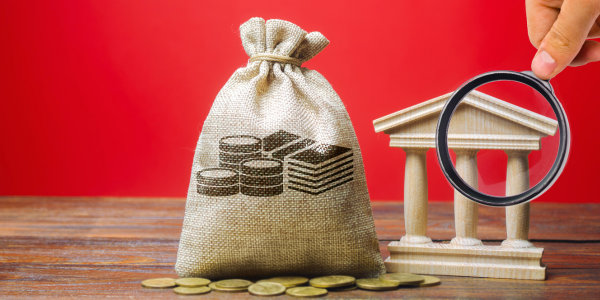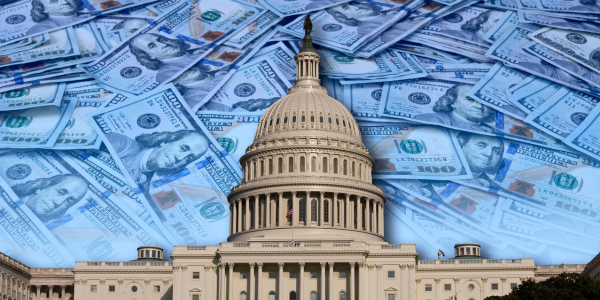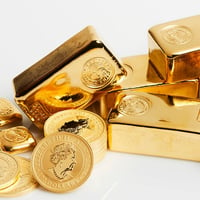For the past thirteen years, Central Banks have been net buyers of gold. In fact, last year,...
The Fed Is a Purely Political Institution, and It's Definitely Not a Bank
Editor's Note: Ryan McMaken (@ryanmcmaken) is executive editor at the Mises Institute. The Mises Institute is the world's leading supporter of the ideas of liberty and the Austrian school of economics. Click here to learn more.
Those who know Wall Street lore sometimes recall that Fed chairman William Miller—Paul Volcker’s immediate predecessor—joked that most Americans believed the Federal Reserve was either an Indian reservation, a wildlife preserve, or a brand of whiskey. The Fed, of course, is none of those things, but there’s also one other thing the Federal Reserve is not: an actual bank. It is simply a government agency that does bank-like things.

It’s easy to see why many people might think it is a bank. “Bank” is right there in the name of the twelve regional banks that make up the system: for example, the Federal Reserve Bank of Kansas City. The Fed also enjoys many titles that make it sound like a bank. It’s sometimes called the “lender of last resort.” Or it is sometimes called “a banker’s bank.” Moreover, many people often call the Fed “the central bank.” That phrase is useful enough, but not quite true.
Moreover, even critics of the bank often repeat the myth that the Federal Reserve is “a private bank,” as if that were the main problem with the Federal Reserve. And then there are the economists who like to spread fairy tales about how the Fed is “independent” from the political system and makes decisions based primarily on economic theory as interpreted by wise economists.
The de facto reality of the Federal Reserve is that it is a government agency, run by government technocrats, that enjoys the benefits of being subject to very little oversight from Congress. It is no more “private” than the Environmental Protection Agency, and it is no more a “bank” than the US Department of the Treasury.

It’s a Purely Political Institution
In its early decades, Congress and the Fed went to some pains to make the Fed look like a private organization that was self-funding, economically solvent, and subject to market forces.
For example, the Federal Reserve System was created—at least on paper—as a very decentralized organization. To this day, it has “shareholders,” which are the private “member” banks of the Federal Reserve. In the early years, the Federal Reserve System’s district banks operated fairly independently. Moreover, these shareholders were (and legally still are) supposed to incur losses when the Federal Reserve is in the red. Back in the days of the gold exchange standard, the Fed had gold reserves and its “banknotes” were supposed to be truly tied to those reserves in the banks. The Fed banks made revenue from discounting bills of exchange and from charging interest on government bonds. These relatively simple organizations were supposed to loan reserve funds to ensure banks had enough liquidity to remain solvent and help deal with financial crises.
The idea of ensuring Fed banks had real capital reserves made some sense when there was a domestic gold standard. But that all changed in a big way with the Great Depression. When Franklin Roosevelt ended the gold standard, the Federal Reserve Banks were forced to hand their gold over to the US Treasury. (To this day, the Fed has no gold.) Then came an enormous expansion of the regulatory state’s role in financial matters, and the Fed became a big part of this. Today, the Fed is far more a regulatory agency than it is any sort of “bank.”

It Monetizes Government Debt
Then, during the Second World War, the mask completely came off the ruse that the Federal Reserve was something other than a way to essentially launder government debt. As the federal government issued enormous amounts of new debt to finance the war, the federal government exhausted the market demand for government bonds at the interest rates the government was able to pay on its debt. So, the Federal Reserve stepped in to buy up large amounts of debt, which kept down interest rates. Fed chairman Henry Morgenthau “simply decreed that interest rates on the federal debt would be ‘pegged’ at low levels.”
This pegging required the Fed to buy up a lot of government bonds. But, of course, by then, the Fed had no gold and no reserves in any meaningful sense. It simply created money to buy up those bonds—thus “monetizing” the debt. There was no economic theory or savvy commonsense “banking logic” at work. This was simply an organization doing what it was told: financing a war for politicians. Moreover, with the dollar no longer tied to gold—especially after the closing of the gold window in 1971—the Fed could create money largely at will.
All of this became progressively normalized in the decades after the war. But it all took an additional great leap away from market-based sanity after the financial crisis of 2008. Since then, the Federal Reserve has routinely bought up both government debt and mortgage securities as a means of both propping up asset values for politically connected banks and enabling ever-larger amounts of deficit spending by the federal government. For example, when federal politicians in 2020 and 2021 wanted to spend trillions of dollars to pay people to not work during the covid lockdowns, the Federal Reserve was there yet again to make it possible the federal government to issue trillions of dollars in new debt without pushing interest rates up. The Fed did this by adding more than $3 trillion in government bonds to its portfolio. This monetized the new debt in a similar way to what had been done during the Second World War.
Through it all, the Fed has just been there to assist the US regime in implementing a variety of policies.

It Can’t Go Bankrupt
In spite of its record, the Fed continues to keep up the fiction that it is some kind of private organization with a real balance sheet, real assets, and real liabilities. But the Fed also doesn’t adhere to any of the accounting standards that a real bank would employ. As Paul Kupiec and Alex Pollock put it, “Unlike other financial institutions that must comply with GAAP [Generally Accepted Accounting Principles] accounting standards, the Federal Reserve Board decides on the accounting standards it uses to report the Federal Reserve System’s income and balance sheet positions.”
This reality has become important in the past year because, for the first time in a century, the Federal Reserve is losing money. Kupiec and Pollock note, “If the Fed was a bank or other regulated financial institution, it would be closed because it is already deeply economically insolvent.” Yet “‘Innovations’ in accounting policies adopted by the Federal Reserve Board in 2011 suggest that the Board intends to ignore the law” and carry on as if there were nothing wrong. It can do this, of course, because the post-gold-standard Fed can create money at will. These “innovations” are described in detail by Robert Murphy, who noted back in 2011 that the Fed had deliberately changed the way it does its accounting to ensure that bankruptcy is a legal impossibility.
The fake accounting didn’t matter much in 2011, when the Fed was still essentially solvent. But in 2022, honest accounting showed that the Fed was insolvent. How did this happen? It’s a result of the fact that the Fed now has a very similar problem to what the savings and loans had in the late 1980's and early 1990's.
But whatever its cause, the Fed’s current bankruptcy is simply the latest example of how the Fed is in no way a real bank or a private organization that funds itself through prudent self-management in the marketplace. Even worse, the Fed funds itself while in bankruptcy by printing money and inflating away the value of the dollars held by ordinary people. The Fed is just another tax-funded government agency, except that the tax that funds the Fed is the “inflation” tax, in which the Fed steals pieces of wealth from savers and workers as it devalues the dollar for the Fed’s own benefit. Or, as Kupiec and Pollock note, the Fed can “monetize Federal Reserve losses, thereby transferring them indirectly through inflation to anyone holding Federal Reserve notes, dollar denominated cash balances and fixed-rate assets.”
The Fed: it’s not private, it’s not financially sound, it’s not a bank. It’s just another government technocracy that’s ripping us off.




